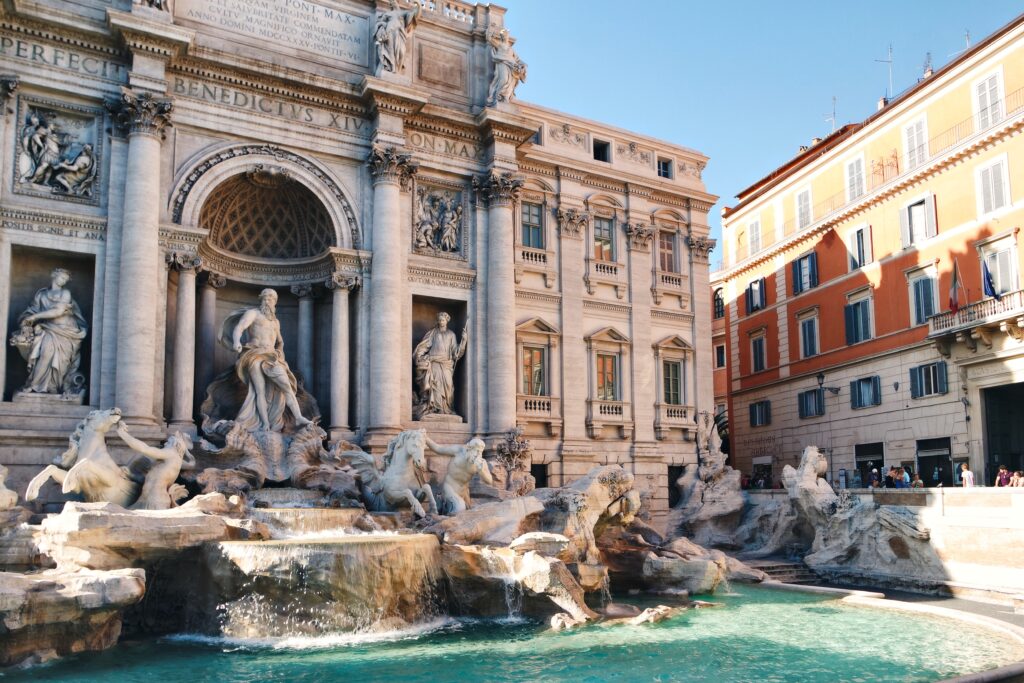

Introduction – Rome Water Mastery
Rome has been called Regina Aquarum, the Queen of Waters, since ancient times. And Rome Water Mastery perfectly describes why: no other ancient city was able to control, guide, and distribute water with such intelligence and innovation.
Below is the full story—yesterday, today, and tomorrow—of how Rome became (and remains) the true Queen of Waters.
Rome Water Mastery
The Queen of Ancient Waters
Rome earned the name Regina Aquarum, the queen of the waters, because more than any other city in the ancient world it knew how to dominate, channel, and distribute water. But how was this possible?
The Genius of Roman Aqueducts
To begin with, Rome was supplied by a vast network of extraordinary aqueducts—marvelous engineering structures that still stand today as a testament to Roman ingenuity. These aqueducts started from various springs around the city and brought in almost one million cubic meters of water per day. That’s an incredible amount—practically one billion liters—a volume unimaginable for any other ancient city.
To visualize it, it would be the equivalent of filling the entire Colosseum with water up to the very top.
Where Rome’s Water Comes From Today
But today, where does Rome’s water actually come from?
Inside the Mountain
The journey begins here: about 100 km north of Rome, on a plateau 410 meters above sea level, at the foot of Mount Nuria. Surprisingly, the water that flows into Rome is born right inside this mountain.
Entering the mountain’s tunnel, the temperature drops sharply. This is because the water emerges directly from deep within the rock.
A Century of Engineering Rome Water Mastery
Although the first studies date back to 1908, the construction of the first tunnels began only in 1938. Despite the challenges of two wars, the aqueduct was inaugurated in 1949. It eventually became one of the largest aqueducts in the world, still delivering 14,000 liters of water per second today.
At the heart of the mountain lies the pure spring itself—the very first fountain, connected directly to the source. The water is so fresh and clean that it already “tastes like Rome.”
A Remarkable Journey to Rome
The Peschiera–Capore System
From this blue-lit cave, the water is collected in basins and travels through tunnels until reaching the Salisano plant, where it merges with the Capore springs.
From here, the system becomes the Peschiera–Capore Aqueduct, traveling roughly 130 km to reach Rome.
Precision Engineering
Moreover, the water takes about 17 hours to arrive in the city, following a precise slope of 4 meters per kilometer—a truly millimetric feat reminiscent of ancient Roman engineering.
Real-Time Monitoring Rome Water Mastery
ACEA monitors the entire route in real time to guarantee the quality of Rome’s water—because let’s be honest, Rome’s water is among the best in the world.
The ACEA Heritage Museum
All maps, models, technical documents, and historical plans of the aqueduct can be explored at the ACEA Heritage Museum in Ostiense. Visitors can even see the new doubling project: a 27-kilometer line designed to reinforce the upper part of the aqueduct and ensure fresh, clean water for future generations.
Conclusion: Yesterday, Today, and Tomorrow
In conclusion, Rome’s relationship with water is a story of brilliance and continuity. From the ancient aqueducts to modern engineering, Rome proves—again and again—that it truly is, and will always be, the Queen of Waters, the Regina Aquarum.
And this is the true essence of Rome Water Mastery.
Useful External Resources
Here are four authoritative links for readers who want to explore more:
- ACEA – Rome Water System
https://www.acea.it - Soprintendenza Archeologia – Roman Aqueducts
https://soprintendenzaspecialeroma.it - Parco degli Acquedotti (Archaeological Park)
https://www.parcoacquedotti.it - UNESCO – Roman Engineering Heritage
https://whc.unesco.org



